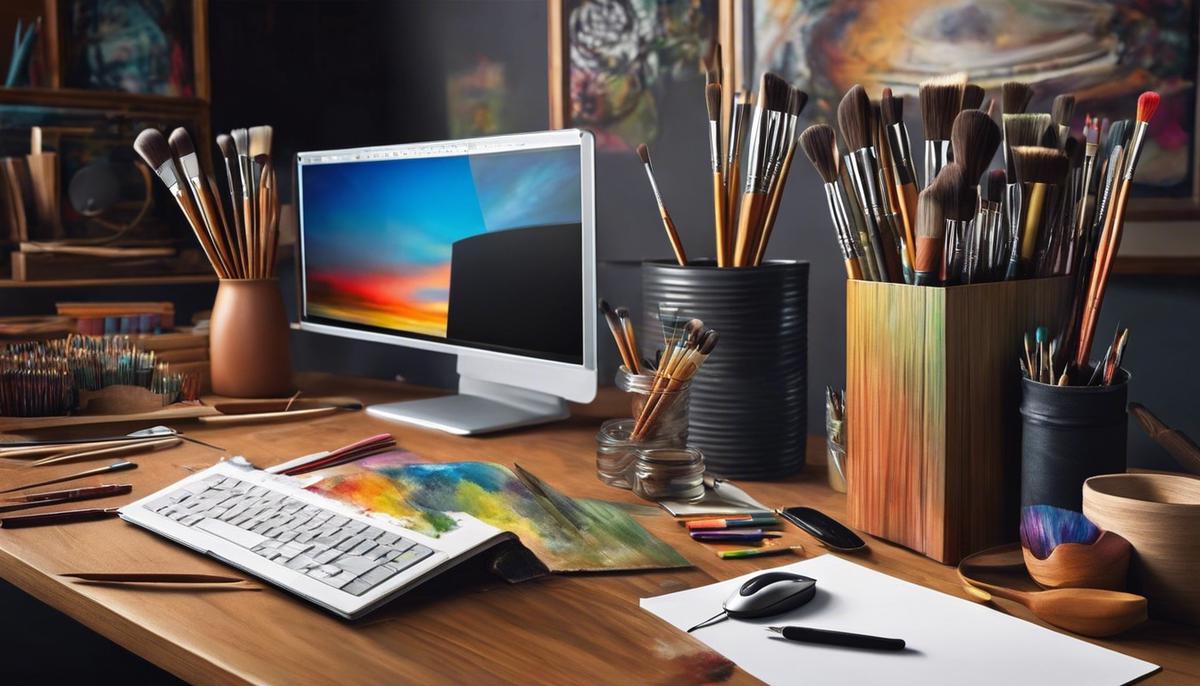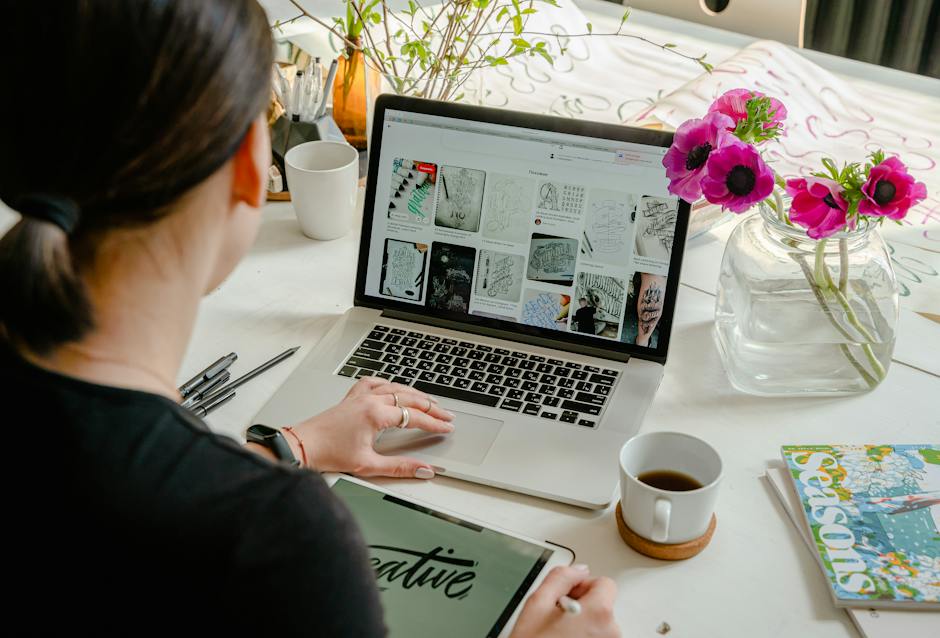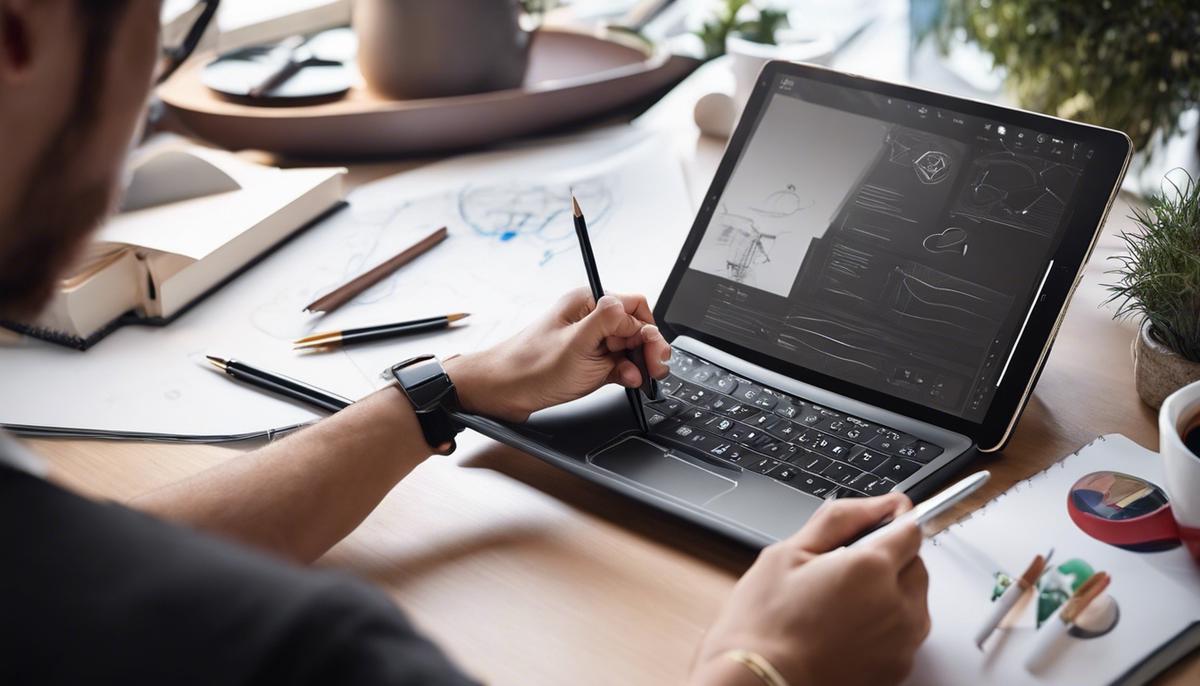In the vibrant tapestry of today’s digital landscape, artists are no longer confined to the physical gallery walls for exhibiting their creations. As the world increasingly pivots towards the virtual realm, establishing an online presence becomes an indispensable facet of an artist’s career. A well-curated portfolio website acts as your digital atelier, a cornerstone where your artistry meets the eye of connoisseurs and admirers worldwide. Embarking on this journey demands an understanding of the sophisticated tools and principles that aid in crafting a visually compelling and easily navigable online showcase for your work. Coupled with the artistic flair, familiarity with the digital brushes of website builders and layout designs can transform your virtual haven into a magnet for viewers and potential patrons alike.
Creating a Portfolio Website
Unlocking the Digital Gallery: A Bold Guide to Showcasing Art Online
In a landscape where brick-and-mortar galleries are increasingly rivalled by virtual spaces, artists find themselves before an exhilarating frontier of exhibition. Behold the age of digital art showcases! Trading in the hallowed whispers of gallery corridors for the dynamic buzz of online platforms, displaying art online is no mere trend – it’s an expansive universe waiting for the audacious artist to stake a claim. Here’s how to do just that, with a flair that only London’s ever-evolving art scene could inspire.
First things first, embrace your website as your personal gallery. It’s the cornerstone of your online presence, your HQ, the place where you control the narrative. Craft a site that mirrors your aesthetic – if your art screams minimalist, don’t let your website scream Times Square billboards. Keep it tidy, make it immersive, and remember, simplicity allows your work to holler with the impact it deserves.
A picture might speak a thousand words, but quality images of your work will sing opera. Splurge if you must on a killer camera or a professional photographer who gets your vibe. The goal is to translate the textures, hues, and soul of your creations as faithfully as possible. Natural lighting is your accomplice in this visual heist, and be sure to capture different angles to give viewers a vicarious tactile experience.
Narrative is king, and your artwork is the story. Each piece has a tale, possibly a tumultuous love affair with your psyche, or a dance with the cultural zeitgeist. Art aficionados and curious browsers alike appreciate a testimonial, an insight, or a cheeky anecdote accompanying your pieces. It personalises the experience, creates connections and sometimes, it’s that personal touch that seals the deal.
Social media is not just for cat memes and breakfast snaps – it’s an instrumental loudhailer for your art. Instagram is the virtual equivalent of an art fair, each post a stall displaying your genius. Use it judiciously, hash-tagging with precision and leveraging Instagram Stories or Reels to offer behind-the-scenes peeks or timelapse videos of your process.
Networks grow not in isolation, but in community gardens. Engage with other artists, art lovers, curators, and critics online. Comment, share, and participate in discussions. Collaboration over competition is the mantra of the digital age. Who knows, the next exciting joint virtual exhibition could be just a friendly exchange away and could expand your audience in ways you haven’t imagined.
Lastly, let’s talk SEO – just a hint, because who wants to drown in acronyms and tech jargon? Simply put, use the right keywords in your website’s text, make sure image descriptions are on point, and blog your heart out about your art, the process, events, and your inspirations. Search engines love a good story and so do people.
In harnessing the power of the world wide web, your art is no longer confined by walls nor limited by geography. It’s out there, pulsating through the virtual veins of the internet, reaching people you’ve never met in places you’ve yet to visit. Let London’s relentless creative energy fuel your online venture – ride the digital wave like you own it, because, in this intrepid new world of online art exhibition, you undeniably do.

Social Media Networking
Diving headfirst into the bustling digital art scene, one mustn’t overlook the diverse palette of social media that can amplify an artist’s presence. Beyond the curated grids of Instagram, a plethora of platforms beckons, each with its unique brushstroke on the canvas of online promotion.
Facebook, with its sprawling community, emerges as a veritable exhibit for artists. The platform offers the capability to create dedicated pages for one’s art, engage with a wider demographic, and even delve into the marketplace to sell creations directly. One can harness the power of event pages to drum up excitement for upcoming shows or gallery openings, making it a valuable tool in the artist’s social media arsenal.
Twitter’s rapid-fire conversation simulates the electric atmosphere of London’s art openings. Artists can leverage the platform for snappy showcases of their latest work, or to stay abreast with trends and discourse in the art world. Moreover, Twitter Chats present an incredible opportunity to participate in real-time dialogues with a community that encompasses critics, galleries, and fellow artists.
Pinterest stands out as a visual search engine, ideal for those who pursue inspiration and strive to become a source of it. The platform’s boards can serve as thematic collections of one’s work, allowing for categorisation by medium, style, or subject. A potent tool for driving traffic to one’s website, Pinterest appeals to collectors and enthusiasts who are craving visual splendour.
For those who tread the cutting edge, TikTok’s dynamic platform cannot be ignored. This is where virality intersects with visual storytelling, and snippets of the creative process can unfold to a vast, engaged audience. The hashtag challenges and the potential to go viral on TikTok offer an unorthodox avenue to capture the public imagination.
LinkedIn provides a more professional stage, ideal for networking with gallery owners, securing commissions, or uncovering collaborations. Despite its corporate veneer, the platform can be a crucible for establishing one’s career and engaging with industry professionals whilst sharing one’s artistic journey.
Lastly, YouTube beckons as the grand stage for videography. Here, artists can broadcast studio tours, timelapse videos of their process, or insightful documentaries that delve deep into the concepts behind their creations. A well-maintained YouTube channel can not only enthrall an audience but also provide a comprehensive look into the artist’s world.
While navigating these digital realms, one must remember the golden rule – consistency. Regular updates, sustained engagement, and authentic content pave the way to building a substantial online presence. Now, harness the power of these platforms, weave the narrative of your art, and send it soaring across the vast digital expanse, for the world is but a click away from witnessing your artistic genius.

Content Creation and SEO
Hold onto your easels, artists! It’s time to dive deeper into the magical realms of SEO – the ultimate sorcery for bolstering your online presence and having your art seen by eyes from across the world. Here’s a cache of tips to enchant search engines and skyrocket your visibility in the digital artscape.
Keyword Research: Find Your Artistic Niche’s LexiconFirst, uncover the words and phrases that potential admirers use to scout for art. Think of keywords as the breadcrumbs that guide art seekers to your virtual doorstep. Use tools like Google’s Keyword Planner to identify terms that resonate with your style, medium or subject matter. Integrate these keywords naturally into website content, titles, and descriptions. However, be cautious: stuff not your prose with keywords, lest it reads unnaturally and puts off both humans and search engines.
On-Page Optimisation: Curate Your Online Exhibition with Precision
When weaving keywords into your website, mind not to trample the integrity of your work. Focus on title tags and meta descriptions – these are your artworks’ placards on the digital wall. Ensure they’re not only descriptive and keyword-rich but also intriguing, inviting onlookers to step closer and explore further.
Moreover, structure your website with clean, clear URLs. Use descriptive slug lines that include keywords and make navigation seamless. A website that mirrors a well-curated gallery scores points with search engines and potential collectors alike.
Image SEO: Your Artwork Takes the Spotlight
Now, when your art speaks for itself online, it’s silent to search engines without alt text – the descriptive tags that narrate your images to search bots. Describe your art succinctly in alt text, embedding keywords where appropriate. Not only does this improve accessibility for those who rely on screen readers, but it also benefits your search engine rankings.
Blogging: An Artist’s Journal for the WorldA blog can serve as your very own palimpsest, continuously evolving with the layers of your artistic journey. Share insights into your creative process, spotlight new collections or dissect the concepts behind your art. Use relevant keywords naturally within your posts to lure in curious minds and engage them with your artistic narrative.
Backlinks: The Secret Handshakes of the WebSearch engines trust websites that other websites trust. Forge connections with fellow creatives, art bloggers, or digital galleries to earn backlinks – links from their site to yours. These act as endorsements, boosting your credibility and thus, your search engine standing. Reach out, collaborate, or contribute guest posts to like-minded platforms to expand your digital handprint.
Analytics: Your Map to Online TreasureEmbark on an analytical adventure with tools like Google Analytics. By understanding the performance of your content and the behavior of your audience, you can refine your SEO strategy. Track which keywords reel in visitors and which pages captivate them the most. Then, adjust your sails accordingly.
Accessibility: Open Your Virtual Doors to AllGuarantee your website is as inclusive as possible. Use strong contrasts, adequate font sizes, and provide transcripts for any audiovisual content. Not only does this invite a wider audience to appreciate your art, it also pleases search engines that factor accessibility into their algorithms.
Mobile Optimisation: Art on the GoIn a world where viewers scroll through galleries on their phones more often than not, a mobile-friendly website is paramount. Ensure your website’s responsive design accommodates different screen sizes. Search engines, particularly Google, favor mobile-friendly sites when ranking search results.
Local SEO: Become the Talk of the TownGeotagging can anchor your art within a local community. Use local keywords, register with Google My Business, and include your location in metadata to capture an audience in your vicinity. Often, global success starts with local recognition.
Above all, SEO for artists is about making your art discoverable, accessible and engaging in the digital epoch. It’s the craft of positioning your artwork within the vast galleries of the internet, ensuring it’s found by those who would cherish it most. Harness these tools with artfulness and watch your audience grow, as expansive and boundless as the web itself.
Now, off you go; create, optimise, and conquer the digital canvas!

Forging a path through the digital world as an artist is akin to painting a picture with an audience in mind; every brushstroke of content and every hue of SEO tactic plays a crucial role in the masterpiece of your online presence. Embrace the journey of continuous learning and refinement of your online strategies, as they will be the lenses through which the beauty of your artwork is magnified and appreciated. May your virtual gallery flourish, engaging with art lovers across the globe and echoing your creative voice far beyond the confines of a traditional studio.

























